A First Estimation of County-Based Green Water Availability and Its Implications for Agriculture and Bioenergy Production in the United States
Abstract
1. Introduction
2. Review of Current Water Availability Assessment Metrics
3. Method for Green Water Availability Assessment
3.1. Application to Agricultural Crop Production
3.2. Crop Water Requirement and Green Water Footprint
3.3. Green Water Resource Estimation
3.3.1. ER Based on the USDA-SCS Method
3.3.2. ER Based on the Smith Method
3.3.3. ER Based on the NHDPlus V2 Data
3.3.4. Advantages and Limitations of the Three ER Estimation Methods
3.4. Study Area and Data Sources
4. Results and Discussion
4.1. Comparison of Green Water Resources Estimated by Three Methods
4.2. Regional and County-Level Green Water Availability
4.3. Green Water Availability by Crop Type
4.4. Annual Versus Growing Season Green Water Availability
4.5. Implications of Regional Water Resource Management for Bioenergy Production
4.6. Limitations and Future Work
5. Conclusions
Disclaimer
Supplementary Materials
Acknowledgments
Author Contributions
Conflicts of Interest
References
- Vörösmarty, C.J.; McIntyre, P.B.; Gessner, M.O.; Dudgeon, D.; Prusevich, A.; Green, P.; Glidden, S.; Bunn, S.E.; Sullivan, C.A.; Liermann, C.R.; et al. Global threats to human water security and river biodiversity. Nature 2010, 467, 555–561. [Google Scholar] [CrossRef] [PubMed]
- Rockström, J.; Steffen, W.; Noone, K.; Persson, A.; Chapin, F.S.; Lambin, E.F.; Lenton, T.M.; Scheffer, M.; Folke, C.; Schellnhuber, H.J.; et al. A safe operating space for humanity. Nature 2009, 461, 472–475. [Google Scholar] [CrossRef] [PubMed]
- Gerten, D.; Hoff, H.; Rockström, J.; Jägermeyr, J.; Kummu, M.; Pastor, A.V. Towards a revised planetary boundary for consumptive freshwater use: Role of environmental flow requirements. Curr. Opin. Environ. Sustain. 2013, 5, 551–558. [Google Scholar] [CrossRef]
- Mekonnen, M.M.; Hoekstra, A.Y. Four billion people facing severe water scarcity. Sci. Adv. 2016, 2, e1500323. [Google Scholar] [CrossRef] [PubMed]
- Kummu, M.; Guillaume, J.H.A.; de Moel, H.; Eisner, S.; Flörke, M.; Porkka, M.; Siebert, S.; Veldkamp, T.I.E.; Ward, P.J. The world’s road to water scarcity: Shortage and stress in the 20th century and pathways towards sustainability. Sci. Rep. 2016, 6, 38495. [Google Scholar] [CrossRef] [PubMed]
- Falkenmark, M. Growing water scarcity in agriculture: Future challenge to global water security. Philos. Trans. R. Soc. A Math. Phys. Eng. Sci. 2013, 371, 20120410. [Google Scholar] [CrossRef] [PubMed]
- Averyt, K.; Meldrum, J.; Caldwell, P.; Sun, G.; McNulty, S.; Huber-Lee, A.; Madden, N. Sectoral contributions to surface water stress in the coterminous United States. Environ. Res. Lett. 2013, 8, 35046. [Google Scholar] [CrossRef]
- Gerten, D.; Heinke, J.; Hoff, H.; Biemans, H.; Fader, M.; Waha, K. Global Water Availability and Requirements for Future Food Production. J. Hydrometeorol. 2011, 12, 885–899. [Google Scholar] [CrossRef]
- USGS (U.S. Geological Survey). WaterWatch. Available online: https://waterwatch.usgs.gov/new/index.php?id=ww_past (accessed on 16 July 2017).
- US Census Bureau Census. 2010. Available online: http://quickfacts.census.gov/qfd/states/13/13135.html (accessed on 16 May 2015).
- Moore, B.C.; Coleman, A.M.; Wigmosta, M.S.; Skaggs, R.L.; Venteris, E.R. A high spatiotemporal assessment of consumptive water use and water scarcity in the conterminous United States. Water Resour. Manag. 2015, 29, 5185–5200. [Google Scholar] [CrossRef]
- Roy, S.B.; Chen, L.; Girvetz, E.H.; Maurer, E.P.; Mills, W.B.; Grieb, T.M. Projecting water withdrawal and supply for future decades in the U.S. under climate change scenarios. Environ. Sci. Technol. 2012, 46, 2545–2556. [Google Scholar] [CrossRef] [PubMed]
- Tidwell, V.C.; Moreland, B.D.; Zemlick, K.M.; Roberts, B.L.; Passell, H.D.; Jensen, D.; Forsgren, C.; Sehlke, G.; Cook, M.A.; King, C.W.; et al. Mapping water availability, projected use and cost in the western United States. Environ. Res. Lett. 2014, 9, 64009. [Google Scholar] [CrossRef]
- Sun, G.; Mcnulty, S.G.; Myers, J.A.M.; Cohen, E.C. Impacts of Climate Change, Population Growth, Land Use Change, and Groundwater Availability on Water Supply and Demand across the Conterminous U.S. Water Supply 2008, 6, 1–30. [Google Scholar]
- Caldwell, P.V.; Sun, G.; McNulty, S.G.; Cohen, E.C.; Moore Myers, J.A. Impacts of impervious cover, water withdrawals, and climate change on river flows in the conterminous US. Hydrol. Earth Syst. Sci. 2012, 16, 2839–2857. [Google Scholar] [CrossRef]
- Hoekstra, A.Y.; Chapagain, A.K.; Aldaya, M.M.; Mekonnen, M.M. The Water Footprint Assessment Manual; Earthscan: London, UK, 2011; ISBN 9781849712798. [Google Scholar]
- Falkenmark, M.; Rockström, J. The New Blue and Green Water Paradigm: Breaking New Ground for Water Resources Planning and Management. J. Water Resour. Plan. Manag. 2006, 132, 129–132. [Google Scholar] [CrossRef]
- Liu, J.; Yang, H.; Gosling, S.N.; Kummu, M.; Flörke, M.; Pfister, S.; Hanasaki, N.; Wada, Y.; Zhang, X.; Zheng, C.; et al. Water scarcity assessments in the past, present, and future. Earth’s Future 2017, 5, 545–559. [Google Scholar] [CrossRef]
- Núñez, M.; Pfister, S.; Antón, A.; Muñoz, P.; Hellweg, S.; Koehler, A.; Rieradevall, J. Assessing the Environmental Impact of Water Consumption by Energy Crops Grown in Spain. J. Ind. Ecol. 2013, 17, 90–102. [Google Scholar] [CrossRef]
- Liu, J.; Zehnder, A.J.B.; Yang, H. Global consumptive water use for crop production: The importance of green water and virtual water. Water Resour. Res. 2009, 45. [Google Scholar] [CrossRef]
- Mekonnen, M.M.; Hoekstra, A.Y. The green, blue and grey water footprint of crops and derived crop products. Hydrol. Earth Syst. Sci. 2011, 8, 1577–1600. [Google Scholar] [CrossRef]
- White, M.; Gambone, M.; Yen, H.; Arnold, J.; Harmel, D.; Santhi, C.; Haney, R. Regional Blue and Green Water Balances and Use by Selected Crops in the U.S. J. Am. Water Resour. Assoc. 2015, 51, 1626–1642. [Google Scholar] [CrossRef]
- Senay, G.B.; Friedrichs, M.; Singh, R.K.; Velpuri, N.M. Evaluating Landsat 8 evapotranspiration for water use mapping in the Colorado River Basin. Remote Sens. Environ. 2016, 185, 171–185. [Google Scholar] [CrossRef]
- Gerbens-Leenes, P.W.; van Lienden, A.R.; Hoekstra, A.Y.; van der Meer, T.H. Biofuel scenarios in a water perspective: The global blue and green water footprint of road transport in 2030. Glob. Environ. Chang. 2012, 22, 764–775. [Google Scholar] [CrossRef]
- Chiu, Y.W.; Wu, M. Assessing county-level water footprints of different cellulosic-biofuel feedstock pathways. Environ. Sci. Technol. 2012, 46, 9155–9162. [Google Scholar] [CrossRef] [PubMed]
- Wu, M.; Ha, M. Water Consumption Footprint of Producing Agriculture and Forestry Feedstocks, Chapter 8, 2016 Billion-Ton Report, Volume 2: Environmental Sustainability Effects of Select Scenarios from Volume 1; Department of Energy Office of Energy Efficiency & Renewable Energy: Washington, DC, USA, 2017. [Google Scholar]
- Núñez, M.; Pfister, S.; Roux, P.; Antón, A. Estimating water consumption of potential natural vegetation on global dry lands: Building an LCA framework for green water flows. Environ. Sci. Technol. 2013, 47, 12258–12265. [Google Scholar] [CrossRef] [PubMed]
- Quinteiro, P.; Dias, A.C.; Silva, M.; Ridoutt, B.G.; Arroja, L. A contribution to the environmental impact assessment of green water flows. J. Clean. Prod. 2015, 93, 318–329. [Google Scholar] [CrossRef]
- Lathuillière, M.J.; Bulle, C.; Johnson, M.S. Land Use in LCA: Including Regionally Altered Precipitation to Quantify Ecosystem Damage. Environ. Sci. Technol. 2016, 50, 11769–11778. [Google Scholar] [CrossRef] [PubMed]
- Boulay, A.-M.; Hoekstra, A.Y.; Vionnet, S. Complementarities of Water-Focused Life Cycle Assessment and Water Footprint Assessment. Environ. Sci. Technol. 2013, 47, 11926–11927. [Google Scholar] [CrossRef] [PubMed]
- Rodrigues, D.B.B.; Gupta, H.V.; Mendiondo, E.M. A blue/green water-based accounting framework for assessment of water security. Water Resour. Res. 2014, 50, 7187–7205. [Google Scholar] [CrossRef]
- Veettil, A.V.; Mishra, A.K. Water security assessment using blue and green water footprint concepts. J. Hydrol. 2016, 542, 589–602. [Google Scholar] [CrossRef]
- Vanham, D.; Hoekstra, A.Y.; Wada, Y.; Bouraoui, F.; de Roo, A.; Mekonnen, M.M.; van de Bund, W.J.; Batelaan, O.; Pavelic, P.; Bastiaanssen, W.G.M.; et al. Physical water scarcity metrics for monitoring progress towards SDG target 6.4: An evaluation of indicator 6.4.2 “Level of water stress.”. Sci. Total Environ. 2018, 613, 218–232. [Google Scholar] [CrossRef] [PubMed]
- Dastane, N.G. Effective rainfall in irrigated agriculture. In Irrigation and Drainage Paper No. 25; Food and Agriculture Organization of the United Nations: Rome, Italy, 1974. [Google Scholar]
- USDA Soil Conservation Serivce. Irrigation Water Requirements-Chapter 2, Part 623 of the National Engineering Handbook; Natural Resources Conservation Service: Washington, DC, USA, 1993. [Google Scholar]
- Hess, T. Estimating Green Water Footprints in a Temperate Environment. Water 2010, 2, 351–362. [Google Scholar] [CrossRef]
- Brown, A.; Matlock, M.D. A Review of Water Scarcity Indices and Methodologies. Sustain. Consort. 2011, 19, White Paper #106. Available online: https://www.sustainabilityconsortium.org/downloads/a-review-of-water-scarcity-indices-and-methodologies/ (accessed on 15 October 2016).
- Pedro-Monzonís, M.; Solera, A.; Ferrer, J.; Estrela, T.; Paredes-Arquiola, J. A review of water scarcity and drought indexes in water resources planning and management. J. Hydrol. 2015, 527, 482–493. [Google Scholar] [CrossRef]
- Xu, H.; Wu, M. Water Availability Indices—A Literature Review, ANL/ESD-17/5; Argonne National Laboratory Techical Report; Argonne National Laboratory: Lemont, IL, USA, 2017. [Google Scholar]
- Damkjaer, S.; Taylor, R. The measurement of water scarcity: Defining a meaningful indicator. Ambio 2017, 46, 513–531. [Google Scholar] [CrossRef] [PubMed]
- International Organization for Standardization (ISO). ISO 14046:2014 (E) Environmental Management. Water Footprint—Principles, Requirements and Guidelines; International Organization for Standardization: Geneva, Switzerland, 2014. [Google Scholar]
- Boulay, A.M.; Bare, J.; Benini, L.; Berger, M.; Lathuillière, M.J.; Manzardo, A.; Margni, M.; Motoshita, M.; Núñez, M.; Pastor, A.V.; et al. The WULCA consensus characterization model for water scarcity footprints: assessing impacts of water consumption based on available water remaining (AWARE). Int. J. Life Cycle Assess. 2018, 23, 368–378. [Google Scholar] [CrossRef]
- Schyns, J.F.; Hoekstra, A.Y.; Booij, M.J. Review and classification of indicators of green water availability and scarcity. Hydrol. Earth Syst. Sci. 2015, 19, 4581–4608. [Google Scholar] [CrossRef]
- Falkenmark, M. The massive water scarcity now threatening Africa—Why isnt it being addressed? Ambio 1989, 18, 112–118. [Google Scholar]
- Vörösmarty, C.J.; Douglas, E.M.; Green, P.A.; Revenga, C. Geospatial Indicators of Emerging Water Stress: An Application to Africa. AMBIO J. Hum. Environ. 2005, 34, 230–236. [Google Scholar] [CrossRef]
- Pfister, S.; Koehler, A.; Hellweg, S. Assessing the environmental impacts of freshwater consumption in LCA. Environ. Sci. Technol. 2009, 43, 4098–4104. [Google Scholar] [CrossRef] [PubMed]
- Sullivan, C.A.; Meigh, J.R.; Giacomello, A.M.; Fediw, T.; Lawrence, P.; Samad, M.; Mlote, S.; Hutton, C.; Allan, J.A.; Schulze, R.E.; et al. The water poverty index: Development and application at the community scale. Nat. Resour. Forum 2003, 27, 189–199. [Google Scholar] [CrossRef]
- Balcerski, W. Javaslat a vízi létesítmények osztályozásának új alapelveire/A proposal toward new principles underpinning the classification of water conditions. Vízgazdálkodás: A vízügyi dolgozók lapja (Water Manag.) 1964, 4, 134–136. (In Hungarian) [Google Scholar]
- Falkenmark, M.; Lindh, G. How can we cope with the water resources situation by the year 2015? Ambio 1974, 3, 114–122. [Google Scholar]
- Raskin, P.; Gleick, P.; Kirshen, P.; Pontius, G.; Strzepek, K. Comprehensive Assessment of the Freshwater Resources of the World; Stockholm Environmental Institute: Sweden, Stockholm, 1997. [Google Scholar]
- Alcamo, J.; Döll, P.; Henrichs, T.; Kaspar, F.; Lehner, B.; Rösch, T.; Siebert, S. Development and testing of the WaterGAP 2 global model of water use and availability. Hydrol. Sci. J. 2003, 48, 317–337. [Google Scholar] [CrossRef]
- Smakhtin, V.; Revanga, C.; Dol, P. Taking into Account Environmental Water Requirements in Global-Scale Water Resources Assessments; International Water Management Institute (IWMI): Colombo, Sri Lanka, 2005; ISBN 9290905425. [Google Scholar]
- Arthington, A.H.; Bunn, S.E.; Poff, N.L.; Naiman, R.J. The challenge of providing environmental flow rules to sustain river ecosystems. Ecol. Appl. 2006, 16, 1311–1318. [Google Scholar] [CrossRef]
- Pastor, A.V.; Ludwig, F.; Biemans, H.; Hoff, H.; Kabat, P. Accounting for environmental flow requirements in global water assessments. Hydrol. Earth Syst. Sci. 2014, 18, 5041–5059. [Google Scholar] [CrossRef]
- Rockström, J.; Falkenmark, M.; Karlberg, L.; Hoff, H.; Rost, S.; Gerten, D. Future water availability for global food production: The potential of green water for increasing resilience to global change. Water Resour. Res. 2009, 45, W00A12. [Google Scholar] [CrossRef]
- Kummu, M.; Gerten, D.; Heinke, J.; Konzmann, M.; Varis, O. Climate-driven interannual variability of water scarcity in food production potential: A global analysis. Hydrol. Earth Syst. Sci. 2014, 18, 447–461. [Google Scholar] [CrossRef]
- Tidwell, V.C.; Kobos, P.H.; Malczynski, L.A.; Klise, G.; Castillo, C.R. Exploring the Water-Thermoelectric Power Nexus. J. Water Resour. Plan. Manag. 2012, 138, 491–501. [Google Scholar] [CrossRef]
- Brauman, K.A.; Richter, B.D.; Postel, S.; Malsy, M.; Flörke, M. Water depletion: An improved metric for incorporating seasonal and dry-year water scarcity into water risk assessments. Elem. Sci. Anthr. 2016, 4, 83. [Google Scholar] [CrossRef]
- Chaves, H.M.L.; Alipaz, S. An integrated indicator based on basin hydrology, environment, life, and policy: The watershed sustainability index. Water Resour. Manag. 2007, 21, 883–895. [Google Scholar] [CrossRef]
- Palmer, W.C. Keeping Track of Crop Moisture Conditions, Nationwide: The New Crop Moisture Index. Weatherwise 1968, 21, 156–161. [Google Scholar] [CrossRef]
- Woli, P.; Jones, J.W.; Ingram, K.T.; Fraisse, C.W. Agricultural reference index for drought (ARID). Agron. J. 2012, 104, 287–300. [Google Scholar] [CrossRef]
- Devineni, N.; Lall, U.; Etienne, E.; Shi, D.; Xi, C. America’s water risk: Current demand and climate variability. Geophys. Res. Lett. 2015, 42, 2285–2293. [Google Scholar] [CrossRef]
- Meyer, S.J.; Hubbard, K.G.; Wilhite, D.A. A Crop-Specific Drought Index for Corn: I. Model Development and Validation. Agron. J. 1993, 85, 388. [Google Scholar] [CrossRef]
- Wada, Y. Human and Climate Impacts on Global Water Resources; Utrecht University: Utrecht, The Netherlands, 2013. [Google Scholar]
- Quinteiro, P.; Ridoutt, B.G.; Arroja, L.; Dias, A.C. Identification of methodological challenges remaining in the assessment of a water scarcity footprint: A review. Int. J. Life Cycle Assess. 2017. [Google Scholar] [CrossRef]
- Wu, M.; Chiu, Y.; Demissie, Y. Quantifying the regional water footprint of biofuel production by incorporating hydrologic modeling. Water Resour. Res. 2012, 48, 1–11. [Google Scholar] [CrossRef]
- Mekonnen, M.M.; Hoekstra, A.Y. A global and high-resolution assessment of the green, blue and grey water footprint of wheat. Hydrol. Earth Syst. Sci. 2010, 14, 1259–1276. [Google Scholar] [CrossRef]
- Faramarzi, M.; Abbaspour, K.C.; Schulin, R.; Yang, H. Modelling blue and green water resources availability in Iran. Hydrol. Process. 2009, 23, 486–501. [Google Scholar] [CrossRef]
- Wada, Y.; Van Beek, L.P.H.; Viviroli, D.; Drr, H.H.; Weingartner, R.; Bierkens, M.F.P. Global monthly water stress: 2. Water demand and severity of water stress. Water Resour. Res. 2011, 47. [Google Scholar] [CrossRef]
- USDA Soil Conservation Service. Irrigation Water Requirements. Technical Release No.21; Natural Resources Conservation Service: Washington, DC, USA, 1970. [Google Scholar]
- Quinteiro, P.; Sandra, R.; Rey, P.V.; Arroja, L.; Dias, A.C. Addressing the green water scarcity footprint of eucalypt production in Portugal. In Proceedings of the 7th International Congress of Energy and Environment Engineering and Management, Universidade de, Las Palmas, Las Palmas, Spain, 17–19 July 2017. [Google Scholar]
- ASCE-EWRI (Environmental & Water Resources Institute). The ASCE Standardized Reference Evapotranspiration Equation. Report of the Task Committee on Standardization of Reference Evapotranspiration; ASCE-EWRI: Reston, VA, USA, 2005. [Google Scholar]
- Patwardhan, A.S.; Nieber, J.L.; Johns, E.L. Effective Rainfall Estimation Methods. J. Irrig. Drain. Eng. 1990, 116, 182–193. [Google Scholar] [CrossRef]
- Chapagain, A.K.; Hoekstra, A.Y. The blue, green and grey water footprint of rice from production and consumption perspectives. Ecol. Econ. 2011, 70, 749–758. [Google Scholar] [CrossRef]
- Obreza, T.A.; Pitts, D.J. Effective Rainfall in Poorly Drained Microirrigated Citrus Orchards. Soil Sci. Soc. Am. J. 2002, 66, 212. [Google Scholar] [CrossRef]
- Smith, M. CROPWAT: A computer program for irrigation planning and management. In Irrigation and Drainage Paper 46; Food and Agriculture Organization of the United Nations: Rome, Italy, 1992. [Google Scholar]
- McKay, L.; Bondelid, T.; Dewald, T.; Johnston, J.; Moore, R.; Rea, A. NHDPlus Version 2: User Guide; United States Environmental Protection Agency: Washington, DC, USA, 2012. [Google Scholar]
- Ley, T.W.; Stevens, R.G.; Topielec, R.R.; Neibling, W.H. Soil Water Monitoring and Measurement; PNW0475; Washington State University: Washington, DC, USA, 1994. [Google Scholar]
- Soil Survey Staff, Natural Resources Conservation Service, U.S. D. of A. Web Soil Survey. Available online: http://websoilsurvey.nrcs.usda.gov/ (accessed on 2 October 2016).
- Pfister, S.; Bayer, P.; Koehler, A.; Hellweg, S. Environmental impacts of water use in global crop production: Hotspots and trade-offs with land use. Environ. Sci. Technol. 2011, 45, 5761–5768. [Google Scholar] [CrossRef] [PubMed]
- Wolock, D.M.; McCabe, G.J. Explaining spatial variability in mean annual runoff in the conterminous United States. Clim. Res. 1999, 11, 149–159. [Google Scholar] [CrossRef]
- McCabe, G.J.; Wolock, D.M. Independent effects of temperature and precipitation on modeled runoff in the conterminous United States. Water Resour. Res. 2011, 47. [Google Scholar] [CrossRef]
- USDA NRCS USDA Farm Production Regions. Available online: https://www.ers.usda.gov/webdocs/publications/42298/32489_aib-760_002.pdf?v=42487 (accessed on 1 May 2017).
- Daly, C.; Halbleib, M.; Smith, J.I.; Gibson, W.P.; Doggett, M.K.; Taylor, G.H.; Curtis, J.; Pasteris, P.P. Physiographically sensitive mapping of climatological temperature and precipitation across the conterminous United States. Int. J. Climatol. 2008, 28, 2031–2064. [Google Scholar] [CrossRef]
- Homer, C.; Dewitz, J.; Yang, L.; Jin, S.; Danielson, P.; Xian, G.; Coulston, J.; Herold, N.; Wickham, J.; Megown, K. Completion of the 2011 national land cover database for the conterminous United States—Representing a decade of land cover change information. Photogramm. Eng. Remote Sens. 2015, 81, 346–354. [Google Scholar]
- U.S Census Bureau Cartographic Boundary Shapefiles-Counties. Available online: https://www.census.gov/geo/maps-data/data/cbf/cbf_counties.html (accessed on 10 December 2016).
- USDA NASS Quick Stats. https://quickstats.nass.usda.gov/ (accessed on 23 February 2017).
- Basche, A.D.; Kaspar, T.C.; Archontoulis, S.V.; Jaynes, D.B.; Sauer, T.J.; Parkin, T.B.; Miguez, F.E. Soil water improvements with the long-term use of a winter rye cover crop. Agric. Water Manag. 2016, 172, 40–50. [Google Scholar] [CrossRef]
- Mubako, S.T.; Lant, C.L. Agricultural Virtual Water Trade and Water Footprint of U.S. States. Ann. Assoc. Am. Geogr. 2013, 103, 385–396. [Google Scholar] [CrossRef]
- Liu, W.; Yang, H.; Folberth, C.; Wang, X.; Luo, Q.; Schulin, R. Global investigation of impacts of PET methods on simulating crop-water relations for maize. Agric. For. Meteorol. 2016, 221, 164–175. [Google Scholar] [CrossRef]
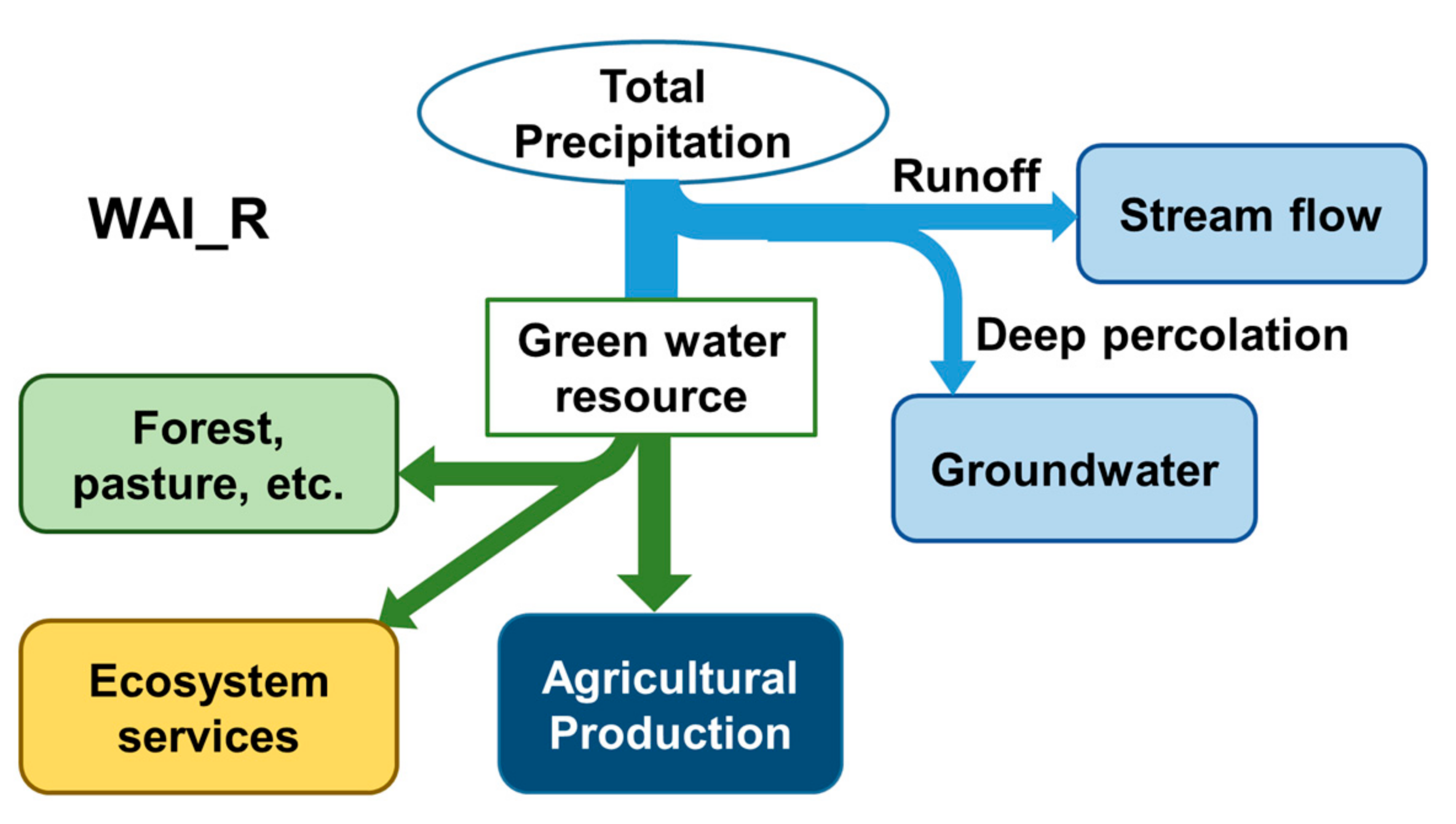
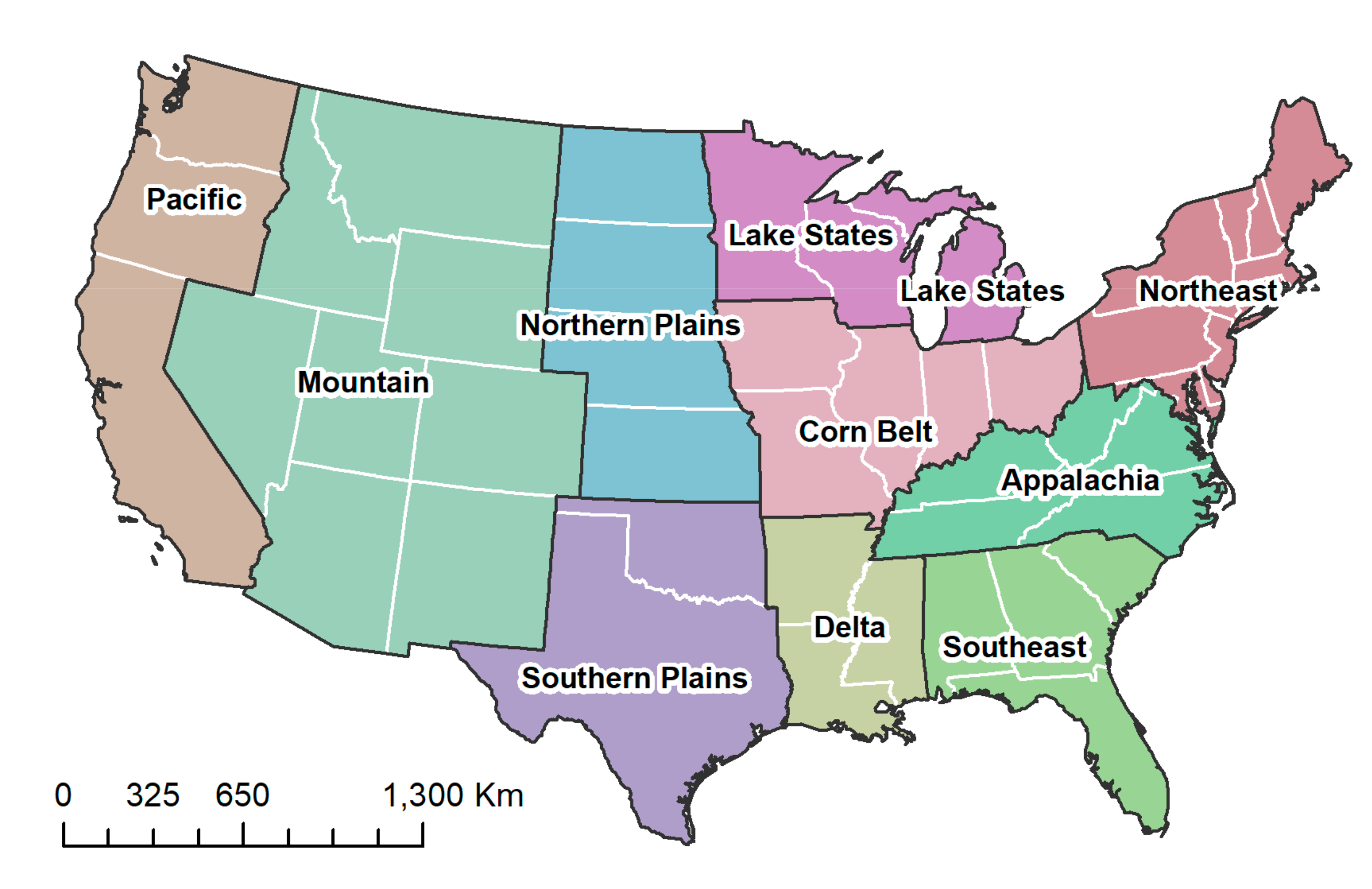
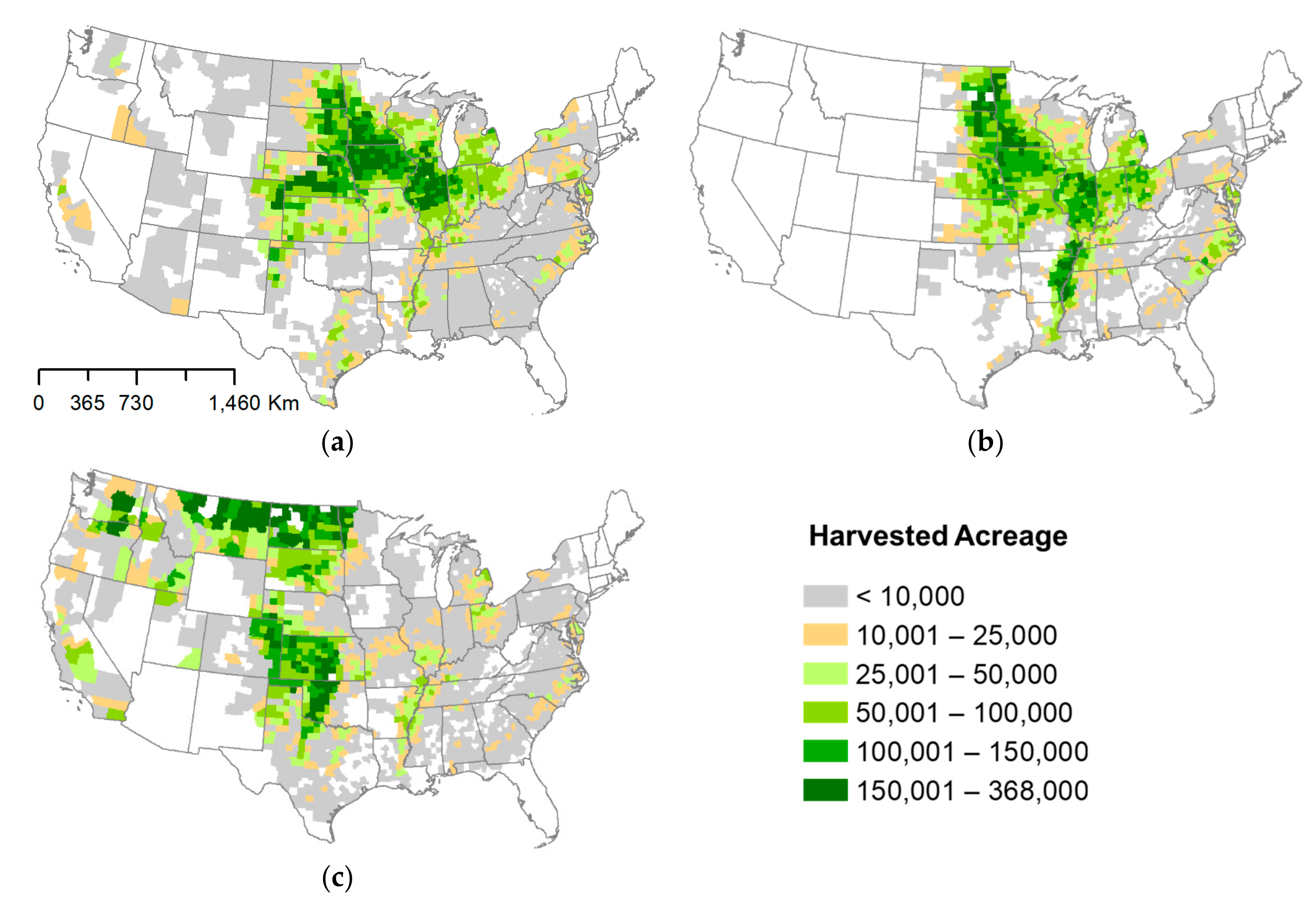
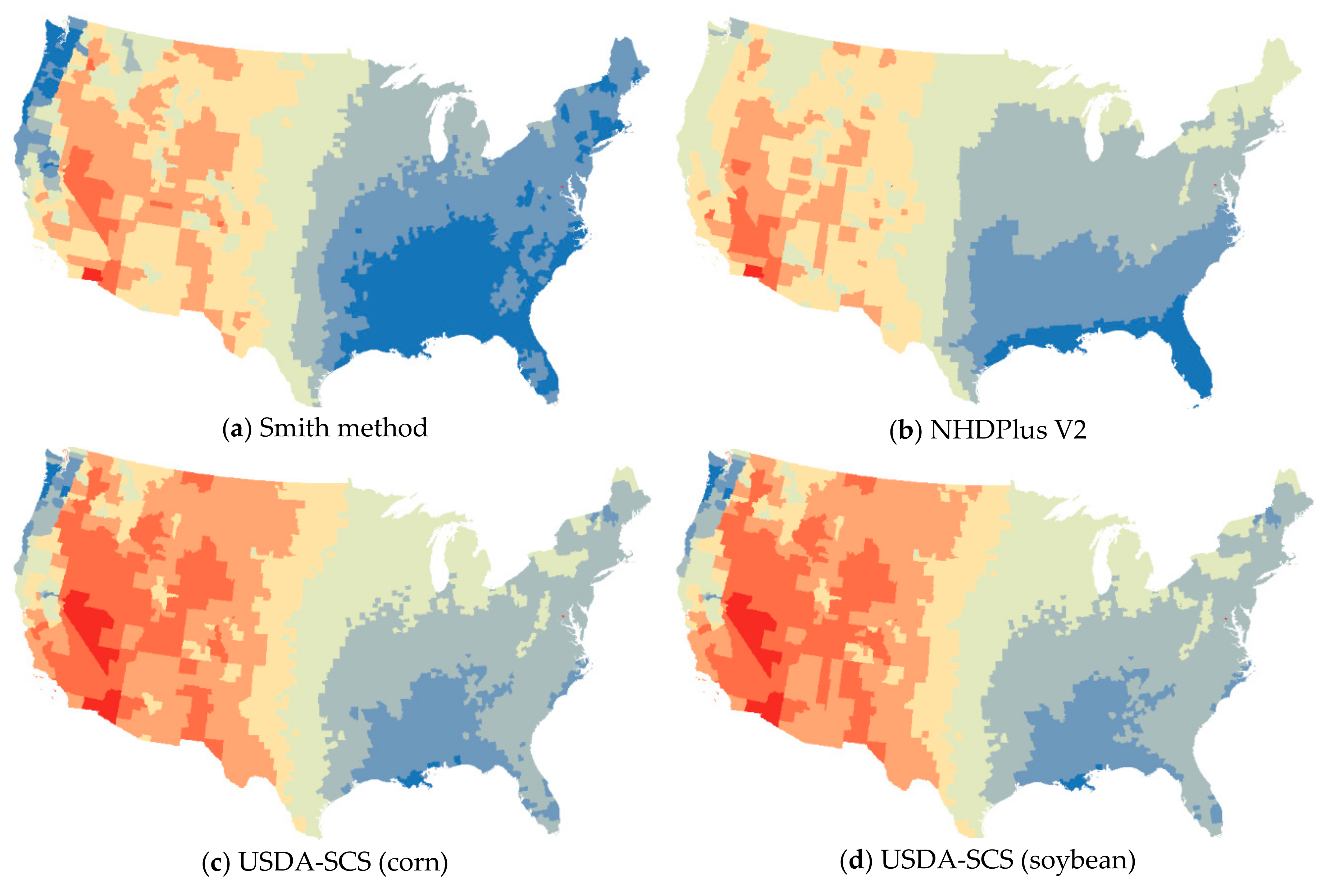

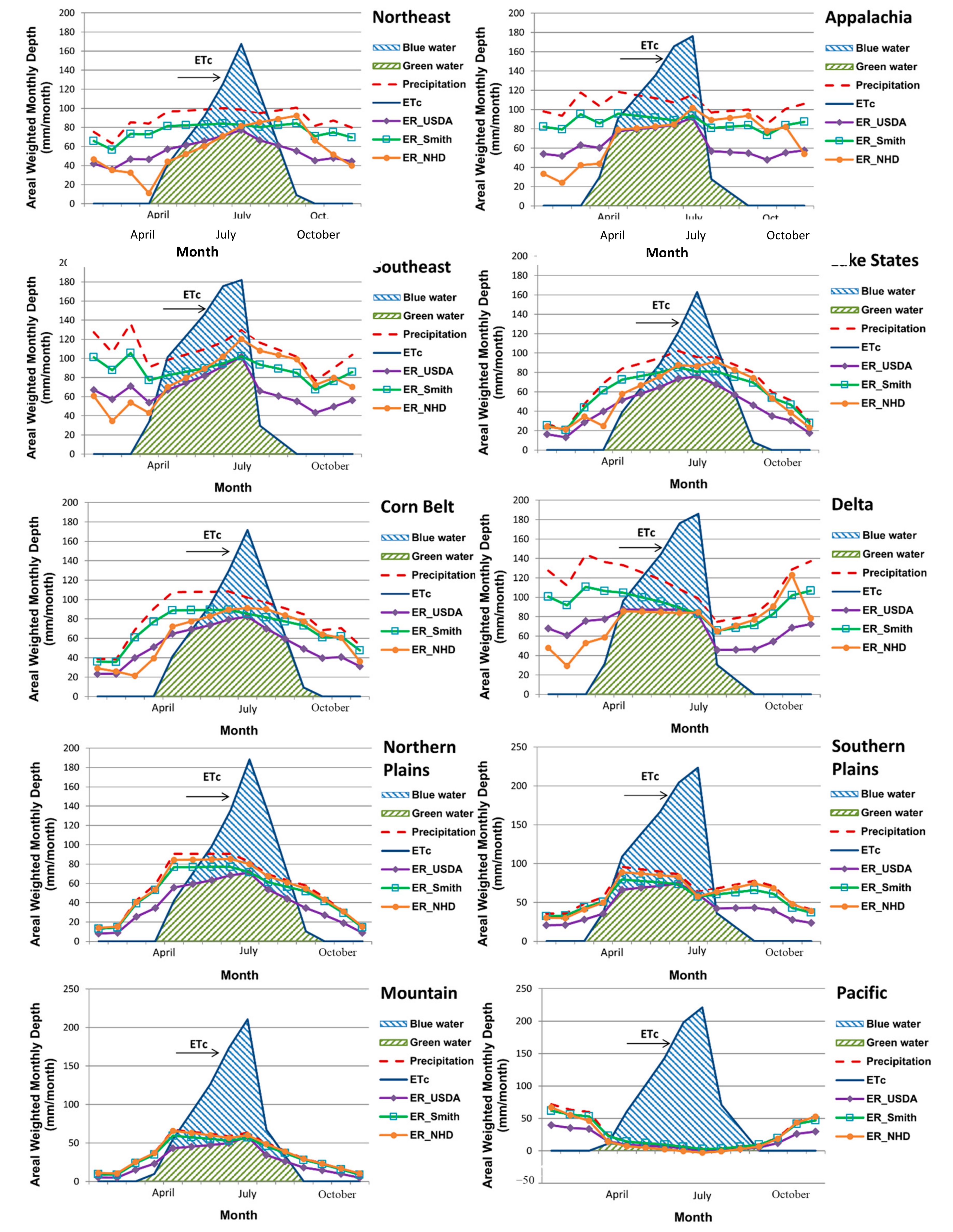
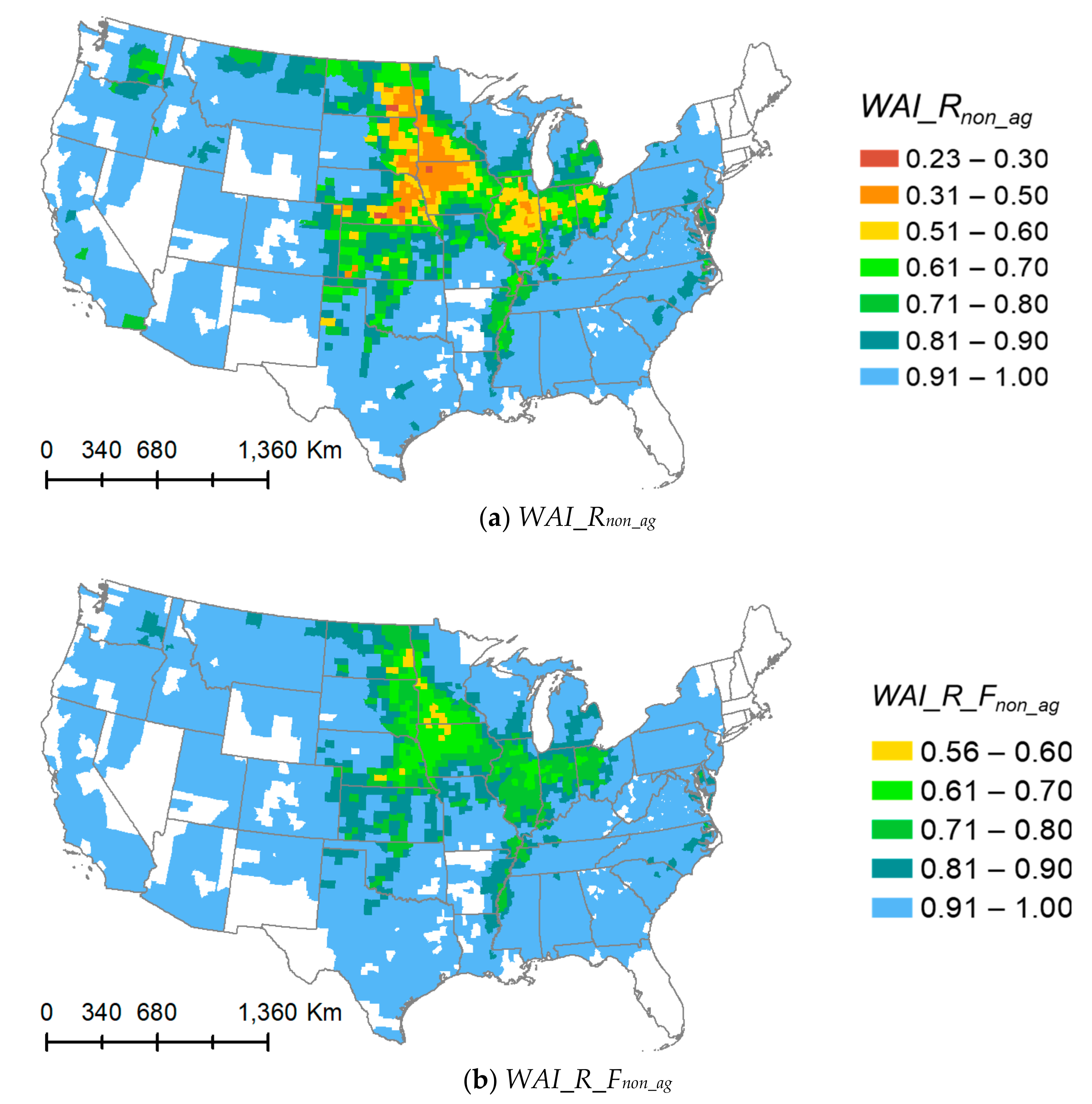
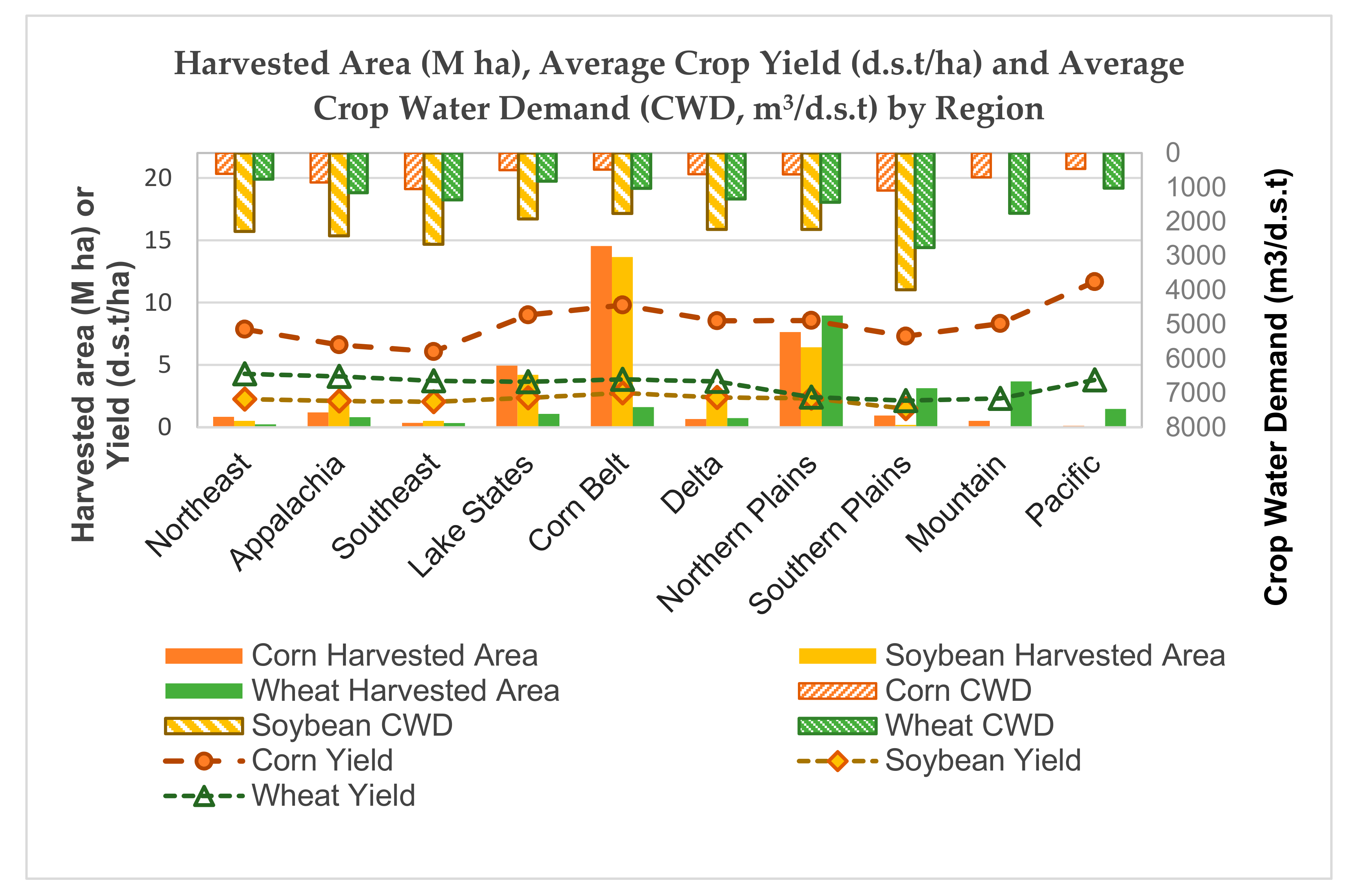
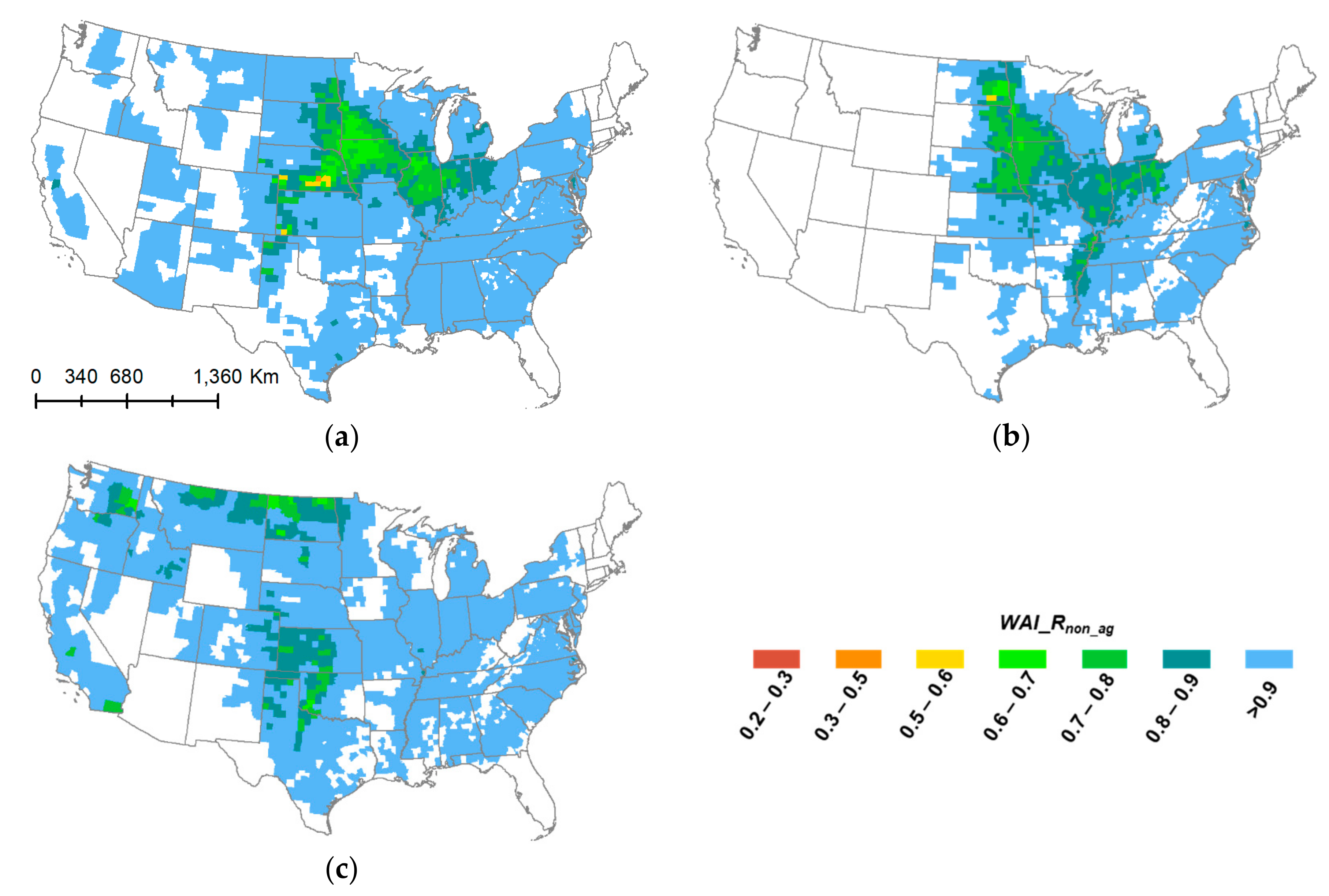

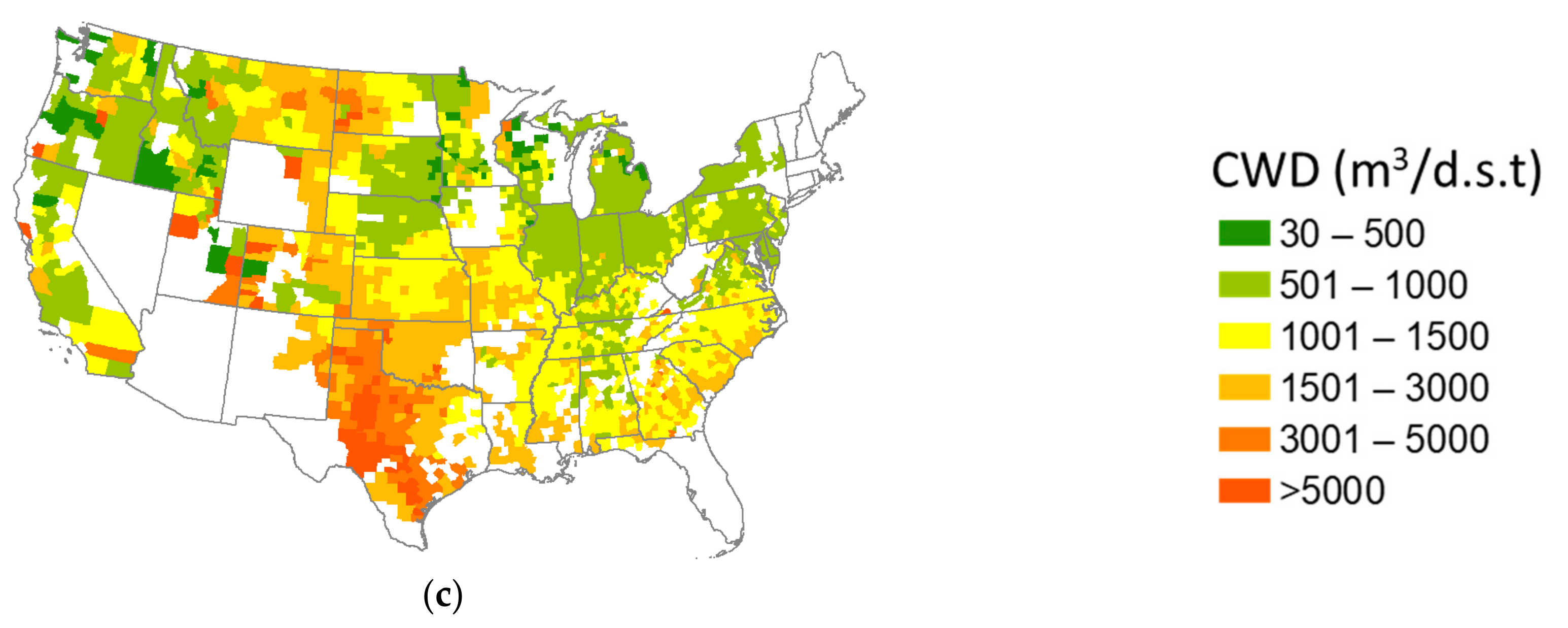
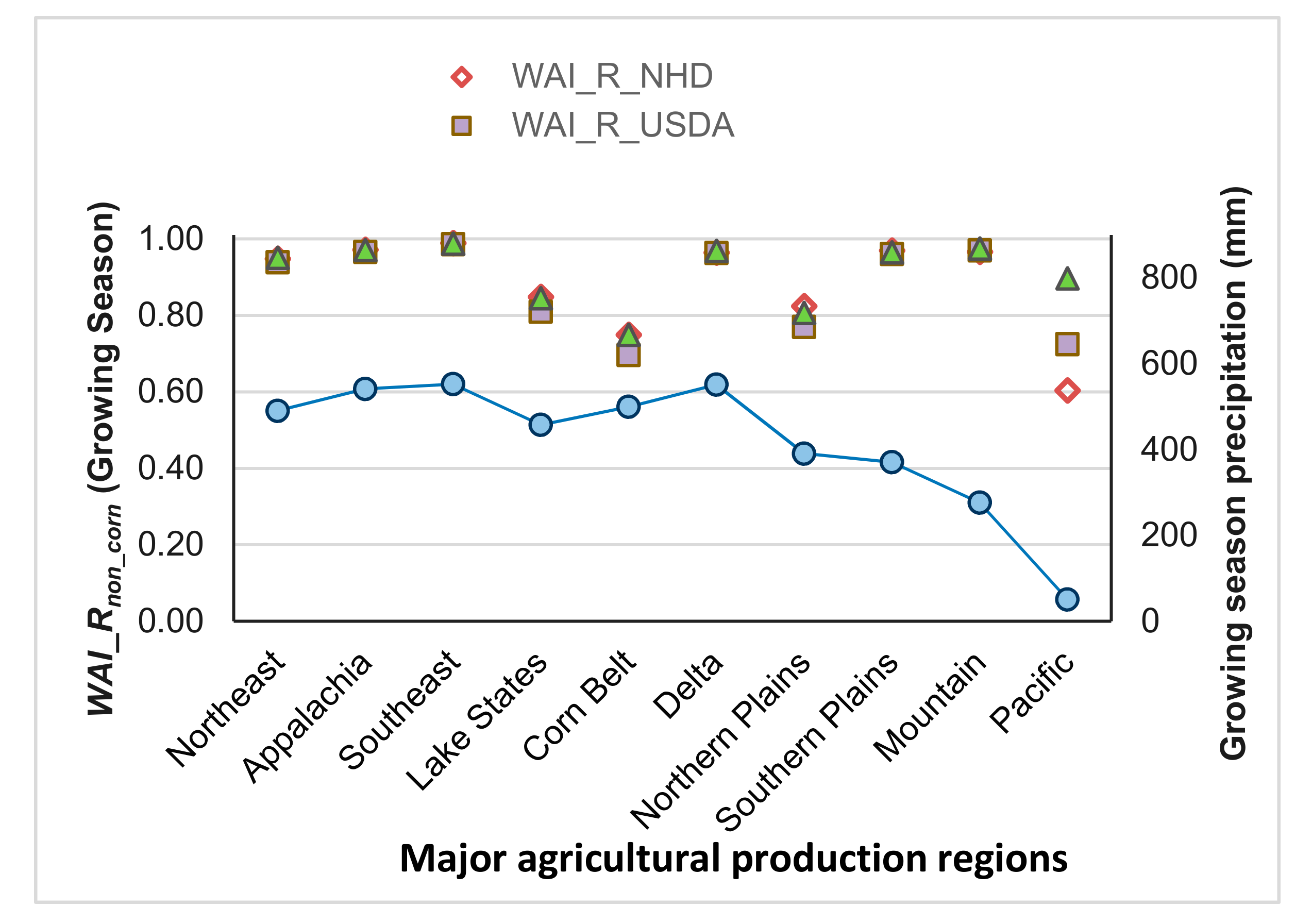
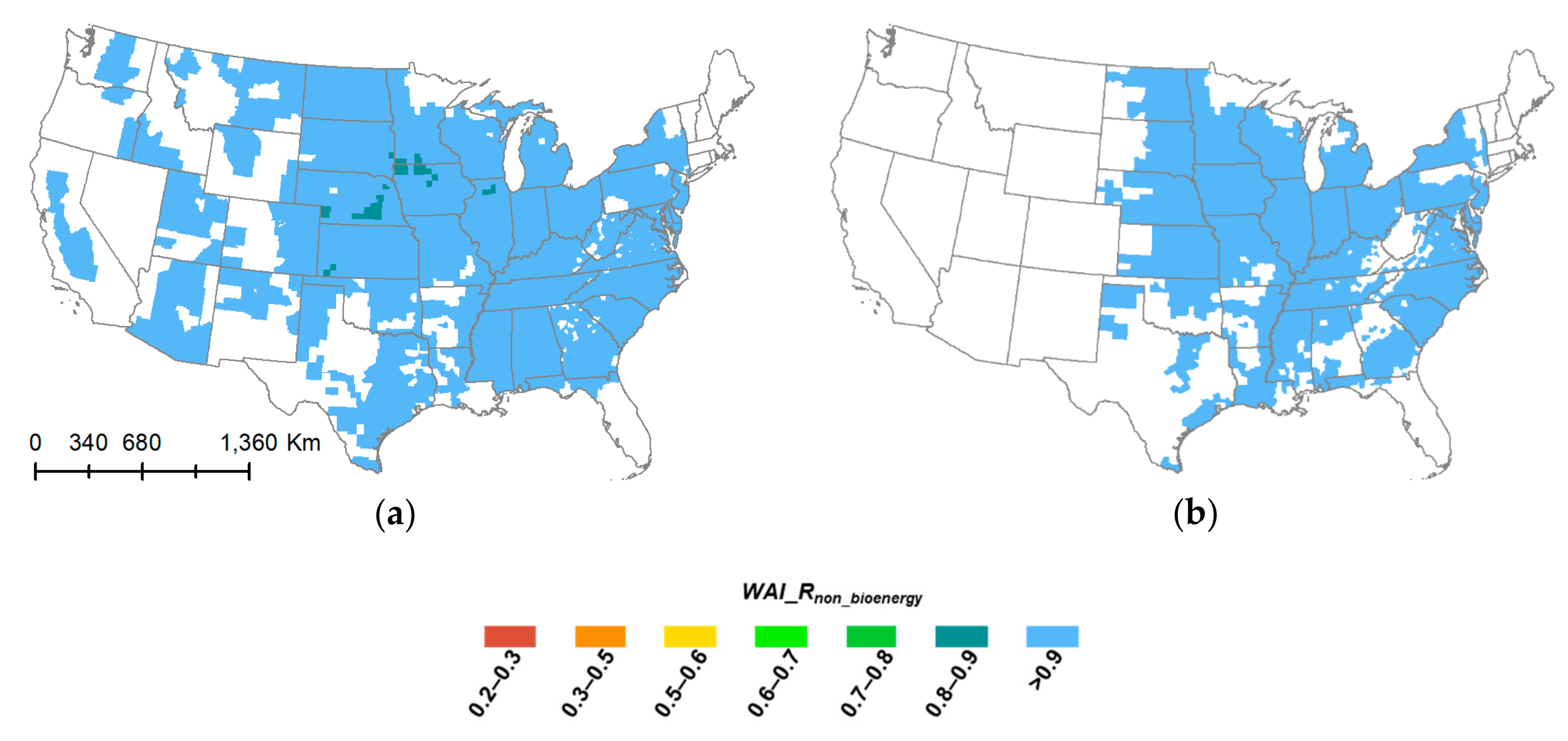
| Category | Blue Water Index | Green Water Index | ||||
|---|---|---|---|---|---|---|
| Key Components | References | Pros and Cons | Key Components | References | Pros and Cons | |
| Water crowding | Predefined thresholds of per-capita share of total annual runoff; human water demand. Data on annual runoff and population is needed. | Falkenmark [44] | Pros: provides an easy to use threshold to assess water scarcity status.Cons: focuses on basic human water demands only; ignores regional differences in per-capita water demand. | Demand of human diet vs. food production; data on consumptive water use of crops and meat production is needed. | Rockström et al. [55]; Gerten et al. [8]; Kummu et al. [56] | Pros: provides an easy-to-use and country-specific threshold to assess water scarcity status.Cons: focuses on basic human water demands only. |
| Use-to-resource ratio | Water withdrawal or consumption to streamflow/surface runoff or groundwater storage. Data on annual withdrawal and runoff is needed. | Vorosmarty et al. [45]; Pfister et al. [46]; Sun et al. [14]; Tidwell et al. [57]; Brauman et al. [58] | Pros: uses multi-sectoral water use and supply data to generate critical ratios for each region.Cons: does not consider EWR. | Crop ET/effective rain; green water footprint (WF)/green water resource. Data on crop ET and effective rain is needed. | Núñez et al. [19]; Rodrigues et al. [31]; Veettil and Mishra [32] | Pros: clear and easy-to-use definitions for both demand and supply variables.Cons: does not address water scarcity at the field level; does not consider EWR. |
| Environmental water requirement (EWR) is also included. Monthly streamflow data is often needed for EWR calculations. | Hoekstra [16]; Smakhtin [52]; Vanham et al. [33] | Pros: is eco-centric, explicitly considers EWR.Cons: it is often difficult to determine appropriate EWR for individual regions. | Data on ET, the area of land reserved for natural vegetation, and ET that cannot be made productive | Hoekstra et al. [16] | Pros: Explicitly considers EWRCons: it is hard to estimate land area that should be reserved for natural vegetation and to determine the portion of ET that is unproductive | |
| Composite index | In addition to physical water demand/supply, considers social and economic factors (e.g., infrastructure). Data inputs vary by indicators, including hydrology, accessibility (e.g., distance, time) and economic and policy capability. | Sullivan et al. [47]; Chaves and Alipaz [59] | Pros: comprehensive, including social factors.Cons: requires extensive data input; may not be straightforward to interpret. | |||
| Variation in ET | Actual ET (AET), reference ET, deficit in soil moisture supply. Data inputs include long-term climate data (e.g., precipitation, temperature) and crop ET. | Palmer [60]; Woli et al. [61]; Devineni et al. [62] | Pros: can identifies abnormal changes in crop ET.Cons: focuses on drought detection, rather than regional water scarcity. | Transpiration (T)/AET; AET/potential ET (PET). Data on T, AET, and PET are needed. | Meyer et al. [63]; Rockström et al. [55]; Wada et al. [64,65] | Pros: can examine changes in site-specific green water flow.Cons: does not provide a critical ratio to describe average local water scarcity status. |
| Item | Timespan | Spatial Resolution | Temporal Resolution | Data Source |
|---|---|---|---|---|
| Corn, soybean and wheat acreages | 2008 | County | Annual | USDA NASS [87] |
| Precipitation | 1971–2000 | 800 m | Monthly | PRISM [84] |
| Potential ET | 1971–2000 | County | Monthly | WATER [25,26,66] |
| Crop coefficient (Kc) | -- | Farm production region | Monthly | WATER [25,26,66] |
| Impervious (urban) area | 2011 | 30 m | -- | NLCD 2011 [85] |
| Land and water surface area | 2015 | County | -- | Cartographic Boundary Shapefiles [86] |
| Runoff | 1971–2000 | 1 km | Monthly | NHDPlus V2 [77] |
| Soil water capacity | 2016 | 1:250,000 (vector) | -- | STATSGO2 [79] |
| Region | Mean WAI_Rnon_ag | Range of WAI_Rnon_ag | Mean WAI_R_Fnon_ag | Range of WAI_R_Fnon_ag |
|---|---|---|---|---|
| Northeast | 0.96 | 0.68–1.0 | 0.97 | 0.79–1.0 |
| Appalachia | 0.96 | 0.62–1.0 | 0.97 | 0.70–1.0 |
| Southeast | 0.98 | 0.82–1.0 | 0.99 | 0.88–1.0 |
| Lake States | 0.83 | 0.33–1.0 | 0.88 | 0.57–1.0 |
| Corn Belt | 0.73 | 0.30–1.0 | 0.82 | 0.57–1.0 |
| Delta | 0.94 | 0.67–1.0 | 0.95 | 0.74–1.0 |
| Northern Plains | 0.71 | 0.23–1.0 | 0.83 | 0.56–1.0 |
| Southern Plains | 0.94 | 0.56–1.0 | 0.97 | 0.73–1.0 |
| Mountain | 0.96 | 0.50–1.0 | 0.98 | 0.76–1.0 |
| Pacific | 0.95 | 0.66–1.0 | 0.98 | 0.83–1.0 |
| National | 0.88 | 0.23–1.0 | 0.92 | 0.56–1.0 |
| WAI_Rnon_ag Range (Unitless) | Number of Counties | Top Four States with Most Counties |
|---|---|---|
| 0.23–0.3 | 5 | Iowa, Nebraska, North Dakota |
| 0.31–0.5 | 106 | Iowa, Minnesota, Nebraska, South Dakota |
| 0.51–0.6 | 138 | Illinois, Iowa, Nebraska, South Dakota |
| 0.61–0.7 | 184 | Illinois, Indiana, Kansas, Iowa |
| 0.71–0.8 | 244 | Kansas, Indiana, Illinois, Montana |
| 0.81–0.9 | 320 | Kansas, Montana, Wisconsin, Indiana |
| 0.91–1.0 | 1697 | Texas, Georgia, Kentucky, Virginia |
| WAI_R_Fnon_ag Range (Unitless) | Number of Counties | Top Four States with Most Counties |
|---|---|---|
| 0.51–0.6 | 17 | Minnesota, Illinois, Nebraska, North Dakota |
| 0.61–0.7 | 138 | Iowa, Minnesota, Nebraska, Illinois |
| 0.71–0.8 | 270 | Illinois, Indiana, Ohio, Iowa |
| 0.81–0.9 | 365 | Kansas, Indiana, Montana, Illinois |
| 0.91–1.0 | 1903 | Texas, Georgia, Kentucky, Virginia |
© 2018 by the authors. Licensee MDPI, Basel, Switzerland. This article is an open access article distributed under the terms and conditions of the Creative Commons Attribution (CC BY) license (http://creativecommons.org/licenses/by/4.0/).
Share and Cite
Xu, H.; Wu, M. A First Estimation of County-Based Green Water Availability and Its Implications for Agriculture and Bioenergy Production in the United States. Water 2018, 10, 148. https://doi.org/10.3390/w10020148
Xu H, Wu M. A First Estimation of County-Based Green Water Availability and Its Implications for Agriculture and Bioenergy Production in the United States. Water. 2018; 10(2):148. https://doi.org/10.3390/w10020148
Chicago/Turabian StyleXu, Hui, and May Wu. 2018. "A First Estimation of County-Based Green Water Availability and Its Implications for Agriculture and Bioenergy Production in the United States" Water 10, no. 2: 148. https://doi.org/10.3390/w10020148
APA StyleXu, H., & Wu, M. (2018). A First Estimation of County-Based Green Water Availability and Its Implications for Agriculture and Bioenergy Production in the United States. Water, 10(2), 148. https://doi.org/10.3390/w10020148





